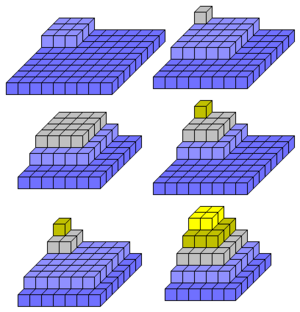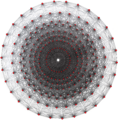90 (number) facts for kids
Quick facts for kids
|
||||
|---|---|---|---|---|
| Cardinal | ninety | |||
| Ordinal | 90th (ninetieth) |
|||
| Factorization | 2 × 32× 5 | |||
| Divisors | 1, 2, 3, 5, 6, 9, 10, 15, 18, 30, 45, 90 | |||
| Greek numeral | Ϟ´ | |||
| Roman numeral | XC | |||
| Binary | 10110102 | |||
| Ternary | 101003 | |||
| Senary | 2306 | |||
| Octal | 1328 | |||
| Duodecimal | 7612 | |||
| Hexadecimal | 5A16 | |||
| Armenian | Ղ | |||
| Hebrew | צ / ץ | |||
| Babylonian numeral | 壹百 | |||
| Egyptian hieroglyph | 𓎎 | |||
90 (ninety) is a natural number. It comes right after 89 and just before 91.
Sometimes, people confuse the numbers 90 and 19 because they sound alike. To tell them apart, listen to which part of the word is stressed. For 19, you stress the "teen" part (nine-TEEN). For 90, you stress the "nine" part (NINE-ty).
Contents
What is 90 in mathematics?
Ninety is a special number in math. It is a pronic number. This means it's the result of multiplying two numbers that come right after each other. For example, 90 is 9 multiplied by 10.
90 is also a Harshad number. This means it can be divided by the sum of its own digits. The digits of 90 are 9 and 0. If you add them (9 + 0), you get 9. And 90 can be divided by 9 (90 ÷ 9 = 10).
The number 90 is the sum of its unitary divisors (not including itself). This makes it a unitary perfect number. It is also a semiperfect number because you can add some of its divisors together to get 90.
You can make 90 by adding up different square numbers in many ways. For example, 90 can be 92 (which is 81) plus 32 (which is 9). So, 81 + 9 = 90. There are six different ways to do this, more than any smaller number!
90 is also twice the ninth triangular number, which is 45.
In math, 90 is related to groups of prime numbers called "prime sextuplets." For example, if you add up the first prime sextuplet (7, 11, 13, 17, 19, 23), you get 90.
90 is a Stirling number of the second kind. This means it's the number of ways you can divide a group of six items into three smaller groups, where none of the smaller groups are empty.
An angle that measures 90 degrees is called a right angle. In shapes like a rectangle, all the corners are right angles. In a right triangle, one of the angles is always a right angle. The other two angles in a right triangle always add up to 90 degrees, making the total 180 degrees.
What is 90 in science?
- 90 is the atomic number of an element called thorium. Thorium is a metal.
- Strontium-90 is a specific type of isotope of strontium. It can be found in milk and is a product of nuclear reactions.
- The North Pole and the South Pole are located at 90 degrees latitude.
What is 90 in sports?
- Nike Total 90 is a brand of football (soccer) clothing and gear.
- In Major League Baseball, the bases are 90 feet (27 m) apart.
- A standard association football (soccer) match lasts for 90 minutes.
What is 90 in other areas?
- If you want to call someone in Turkey from another country, you dial +90 before their phone number.
- 90 is the code for a region in France called Territoire de Belfort.
- Interstate 90 is a very long highway in the United States. It stretches for 3,020 miles (4,860 kilometers) from Seattle, Washington, all the way to Boston, Massachusetts.
Images for kids
See also
 In Spanish: Noventa para niños
In Spanish: Noventa para niños




